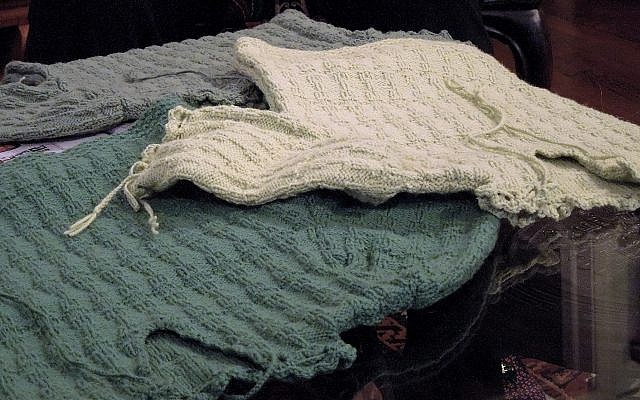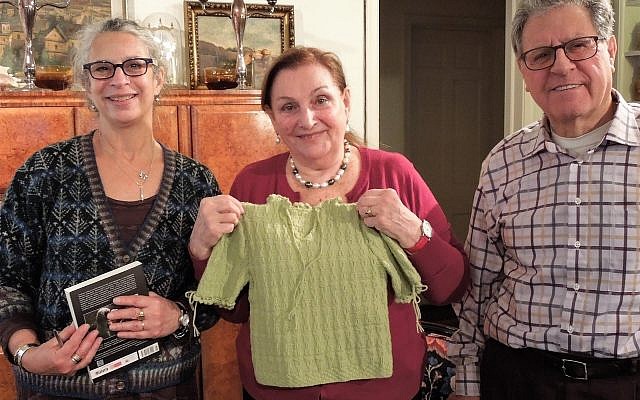In May 1943, seven-year-old Krystyna Chiger escaped the Holocaust into the sewers under the Lvov, Poland, ghetto with her mother, father, and younger brother. Having heard that the ghetto would soon be liquidated, Chiger’s father Ignacy hid his family behind a false basement wall and dug a hole to the sewer system through which they and a dozen other Jews fled.
Many in the group could not bear the cramped pipes, tall enough only for a child, and ended up going above ground. There they were caught and shot to death by the Gestapo. However the Chigers, aided by Catholic sewer workers Leopold Socha, Stefan Wroblewski, and Jerzy Kowalow, managed to survive in the sewers for 14 months, until the city’s liberation by the Soviet Army.
All that time, Krystyna and her family barely moved in the dark and dank ducts. They contended with rats and worms, and pressed themselves against the stone walls to avoid drowning in rushing water. The whole family had lice, and Krystyna and her brother Pavel contracted measles and other illnesses. They survived on meager rations of black bread and margarine smuggled to them by Socha.

The Chiger family in Lvov, Poland. From left: Pawel, Ignacy, Krystyna and Paulina. (Courtesy of Dr. Kristine Keren)
While hiding in the sewers, Krystyna wore a favorite green sweater that was knitted for her before the war by her beloved grandmother. Prior to moving underground, she had witnessed from a ghetto window that her grandmother was carted away to the Janowska concentration camp, where she died.
Krystyna’s green sweater is now being replicated by hundreds of knitters around the world, thanks to Dr. Lea Stern, an expert knitter living in the Washington, DC area. Having spotted the original in a 2003 US Holocaust Memorial Museum exhibition on children who survived World War II in hiding, Stern set out to devise a pattern that would allow any proficient knitter to recreate the garment.
“A child wore this in extreme duress. This is living history and it has to be told. The experiences of children in the Holocaust have to be kept alive,” Stern said in explaining her determination in making the pattern.
An anesthesiologist, Stern was forced to put the project aside for a decade when her husband became terminally ill. But the sweater and Krystyna’s story remained in the back of her mind until she visited the Anne Frank House in Amsterdam in 2012 and decided it was time to put her plan into action.
“It took well over a year for me to convince the museum to give me access to the sweater and let me do this,” Stern said.
According to USHMM curator Suzy Snyder, the green sweater is a popular item. Scholars and visiting fellows often request that it be pulled from storage at the museum’s state-of-the-art David and Fela Shapell Family Collections, Conservation and Research Center for study and examination.
However, the sweater has not been exhibited since the 2003 “Life in Shadows: Hidden Children and the Holocaust” exhibition and a subsequent two-year tour in Michigan, New York and Chicago.

USHMM curator Suzy Snyder (right) handles Krystyna Chiger’s green sweater with a conservator. (Courtesy of the US Holocaust Memorial Museum)
“It’s still in pretty good shape for what it went through. We stabilized it, but we have to be very careful with it because it is a textile, and it is green. We have to be very vigilant about its exposure to light,” Snyder told The Times of Israel.
“We are reticent to loan it out for exhibitions because it is so fragile,” she added.
Snyder found Stern’s request for access to the sweater highly unusual. Stern was actually the second person to approach the museum about reproducing the sweater, but the only one who was persistent.
“To be honest, I thought this was a weird request at first,” said Snyder. “But my sister, who is a big knitter, totally understood Lia’s interest and encouraged me to react differently.”
Soon, Snyder came to understand Stern’s motivation. “We ended up having a great relationship with her. She did this for us and for herself. It became a mission for her,” Snyder said.

Dr. Lea Stern shows Dr. Kristine Keren how she recreated the green sweater. (Julia Grossman)
Stern, 66, was granted permission to closely examine and carefully handle the sweater in April 2014. Familiar with historical knitting stitches and patterns, she thought it would be easy to find the sweater’s pattern published somewhere. Surprisingly, it turned out to be much more difficult than anticipated to “reverse engineer” the garment.
“I looked at every book on stitch patterns and sweater patterns and couldn’t find it. I concluded that this must have been a pattern that was just passed along, or was a pattern in common usage at the time that Krystyna’s grandmother knew,” Stern said.
Having exhausted all historical research, Stern simply figured out on her own the relatively straight-forward combination of knit and purl stitches. “It took me less than a week,” she said.
Stern chose Quince & Co. Finch, a fingering-weight 100 percent wool yarn that offers excellent stitch definition and a large palette of colors. As the Holocaust-era sweater is faded and stained, it is hard to determine its exact original color, but many of the company’s greens are quite close.
The next step was to knit the sweater herself, and also to have knitter friends and relatives test out the pattern.

Samples of the sweater knitted in different shades of green. (Julia Grossman)
Although Dr. Kristine Keren (as Krystyna Chiger is now known) transferred ownership of the sweater to the USHMM following its initial loan for the 2003 exhibition, Stern felt it was only right to seek her approval for the project.
Following the war, Keren and her family lived in Krakow before immigrating to Israel in 1957. Keren studied dentistry in Jerusalem, opened a private practice and married fellow Holocaust survivor Marion Kwasniewski. The couple, who has two sons, moved to the US in 1968, where Keren, now 84, continued her dental practice.
Stern travelled to the retired Keren’s home in Long Island, New York, to show her how she created the pattern for the green sweater. She also brought with her several copies of the sweater in various shades of green and invited a grateful Keren to keep one.

Dr. Kristine Keren (center) holds replica of her green sweater from the Holocaust made from knitting pattern created by Dr. Lea Stern (left). Keren’s husband Marion is at right. (Julia Grossman)
“She chose the one that she said was closest to the original color,” Stern said. “It’s not the green I would have thought the original was, but that’s the shade it was in her memory.”
For decades after the war, Keren’s mother kept the sweater. Then she passed it on to Keren for safekeeping. It wasn’t easy for Keren to donate the only remaining object that connects her to her grandmother killed by the Nazis.
“But I felt that if I will keep this at home, nobody will know [what happened],” Keren said. “The sweater talks about the war.”
Stern donated a prototype of the sweater, along with the pattern copyright to the USHMM. The sweater and pattern are on display in the museum’s gift shop alongside Keren’s book, “The Girl in the Green Sweater: A Life in Holocaust’s Shadow.” The pattern sells for $7.00 at the gift shop, as well as on the Ravelry website, with all proceeds going to the USHMM. Over 1,000 copies of the pattern have been sold since October 2014, with interest in the project heightened since Stern recently published an article on it in Piecework Magazine.

A replica of Krystyna Chiger’s sweater on display at the USHMM book shop alongside the pattern for sale and Dr. Kristine Keren’s book. (Julia Grossman)
Stern, who has created a pattern for an updated, adult-size version of the green sweater, as well as a pattern for another Holocaust-era sweater, said she is amazed by the response she has received.
“I’ve answered hundreds of emails from people all over the world. I’ve been contacted by children of survivors, people concerned about the rise of hatred and divisions in society, teachers, and others,” Stern said.
As much as Stern, a lifelong knitter, loves to create items people will actually wear, she knows the green sweater is about more than merely keeping warm or looking good.
“The sweater itself isn’t necessarily something that kids today would want to wear. Knitting and showing it to others it is a way of passing on the story,” she said.
2019-10-22 08:25:18Z
https://www.timesofisrael.com/knitters-worldwide-recreate-sweater-worn-by-girl-who-survived-holocaust-in-sewer/
CBMib2h0dHBzOi8vd3d3LnRpbWVzb2Zpc3JhZWwuY29tL2tuaXR0ZXJzLXdvcmxkd2lkZS1yZWNyZWF0ZS1zd2VhdGVyLXdvcm4tYnktZ2lybC13aG8tc3Vydml2ZWQtaG9sb2NhdXN0LWluLXNld2VyL9IBAA
Bagikan Berita Ini














0 Response to "Knitters worldwide recreate sweater worn by girl who survived Holocaust in sewer - The Times of Israel"
Post a Comment